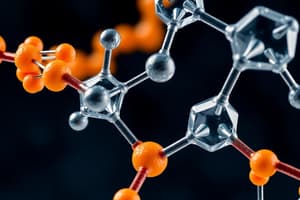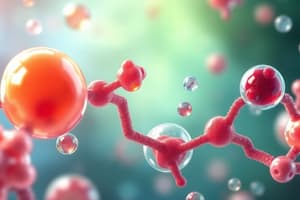Podcast
Questions and Answers
What are biomolecules?
What are biomolecules?
Organic molecules produced by living organisms. Essential for life as they carry out various biological processes such as reproduction, growth, and sustenance.
What are the functions of proteins?
What are the functions of proteins?
Proteins function as enzymes, hormones, and transporters, they are also essential for muscle growth. They are also components of enzymes, antibodies, hemoglobin, and keratin.
What is a coenzyme?
What is a coenzyme?
A non-protein molecule that binds to an enzyme and helps it function properly.
Vitamin B12 is primarily found in plant-based products.
Vitamin B12 is primarily found in plant-based products.
What is the primary function of enzymes?
What is the primary function of enzymes?
Which of the following are the primary functions of enzymes? (Select all that apply).
Which of the following are the primary functions of enzymes? (Select all that apply).
Which of the following is a function of competitive inhibitors?
Which of the following is a function of competitive inhibitors?
What are the functions of coenzymes and cofactors?
What are the functions of coenzymes and cofactors?
What is the main purpose of ATP hydrolysis?
What is the main purpose of ATP hydrolysis?
What is the primary energy currency of cells?
What is the primary energy currency of cells?
The electron transport chain pumps protons into the thylakoid lumen, which is essential for ATP synthesis through chemiosmosis.
The electron transport chain pumps protons into the thylakoid lumen, which is essential for ATP synthesis through chemiosmosis.
What is the primary function of the Calvin cycle?
What is the primary function of the Calvin cycle?
What is the enzyme responsible for fixing carbon dioxide?
What is the enzyme responsible for fixing carbon dioxide?
Aerobic respiration is less efficient and occurs when oxygen is not available.
Aerobic respiration is less efficient and occurs when oxygen is not available.
Which of the following is a type of fermentation?
Which of the following is a type of fermentation?
What is the role of anaerobic respiration in training and competition?
What is the role of anaerobic respiration in training and competition?
Flashcards
Carbohydrates
Carbohydrates
Organic compounds serving as primary energy sources for living organisms.
Lipids
Lipids
Organic compounds that store energy and provide insulation.
Proteins
Proteins
Large molecules essential for various biological functions, including enzymes, hormones, and structural components.
Nucleic Acids
Nucleic Acids
Signup and view all the flashcards
Enzymes
Enzymes
Signup and view all the flashcards
Activation Energy
Activation Energy
Signup and view all the flashcards
Enzyme's Optimal Temperature
Enzyme's Optimal Temperature
Signup and view all the flashcards
Enzyme Denaturation
Enzyme Denaturation
Signup and view all the flashcards
Substrate Concentration
Substrate Concentration
Signup and view all the flashcards
Competitive Inhibitors
Competitive Inhibitors
Signup and view all the flashcards
Metabolic Pathway
Metabolic Pathway
Signup and view all the flashcards
Coenzymes
Coenzymes
Signup and view all the flashcards
Cofactors
Cofactors
Signup and view all the flashcards
ATP-ADP Cycle
ATP-ADP Cycle
Signup and view all the flashcards
Endergonic Reaction
Endergonic Reaction
Signup and view all the flashcards
ATP Hydrolysis
ATP Hydrolysis
Signup and view all the flashcards
Vitamin B12
Vitamin B12
Signup and view all the flashcards
Vitamin A
Vitamin A
Signup and view all the flashcards
Vitamin B1
Vitamin B1
Signup and view all the flashcards
Biomolecules
Biomolecules
Signup and view all the flashcards
Study Notes
Carbohydrates
- Energy source, providing sustained energy
- Include glucose, fructose, sucrose, starch, and cellulose
- Examples: bread, pasta, rice, cereals, oats, almonds, and dried fruits
Lipids
- Store energy and provide insulation
- Examples include fats, oils, waxes, cholesterol, oils, avocados, and dark chocolates
Proteins
- Function as enzymes, hormones, and transporters; crucial for muscle growth
- Include enzymes, antibodies, hemoglobin, and keratin
- Examples: meat, fish, dairy products, peanuts, soy products, almonds, and dried fruits
Biomolecules
- Organic molecules produced by living organisms, essential for life
- Crucial for biological processes like reproduction, growth, and sustenance
Nucleic Acids
- Store and transmit genetic information
- Include DNA and RNA
Vitamins
- Often act as coenzymes, assisting enzymes in their function
- Deficiency can disrupt enzyme function, leading to health problems
- Vitamin B12 is crucial for vegans; deficiency relates to anemia and nerve damage
- Vitamin A essential for vision, especially in low light
- Vitamin B1 (thiamine) supports carbohydrate conversion to energy
Enzymes
- Biological catalysts accelerating chemical reactions
- Lower activation energy, increasing reaction rates
- Function optimally at specific temperatures and pH
- High temperatures cause denaturation, destroying enzyme structure and function.
- Substrate concentration affects the rate of enzymatic reactions, up to a saturation point.
Coenzymes and Cofactors
- Assist enzymes, contributing to substrate binding and providing crucial functional groups
- Crucial for enzymatic function
ATP-ADP Cycle
- ATP (adenosine triphosphate) is a primary energy currency for cells
- ADP (adenosine diphosphate) is a byproduct of ATP hydrolysis.
- ATP synthesis is endergonic, requiring energy input, often from glucose breakdown
- ATP hydrolysis releases the energy stored in phosphodiester bonds. A crucial process in essential cell functions.
Photosynthesis (Light Dependent Reaction Chloroplast)
- Converts light energy into chemical energy
- Water splitting is the first step, releasing H+ and electrons
- Electrons move through an electron transport chain, creating a proton gradient
- Oxygen produced as a byproduct
- ATP and NADPH are generated; crucial for the Calvin cycle.
Calvin Cycle (Light Independent Reaction)
- Fixes atmospheric CO2 into organic molecules (e.g., glucose).
- RuBisCO (ribulose-1,5-bisphosphate carboxylase/oxygenase) is crucial for fixing atmospheric carbon dioxide
- The Calvin cycle plays a vital role in photosynthesis by converting inorganic carbon dioxide into organic compounds, crucial for plant growth.
Cellular Respiration
- Aerobic: Breaks down glucose in the presence of oxygen
- Includes glycolysis, Krebs cycle, and the electron transport chain (ETC).
- Anaerobic: Occurs in absence of oxygen
- Includes glycolysis and fermentation; producing less ATP than aerobic respiration.
- Lactic acid and alcoholic fermentation are examples of anaerobic respiration
- Aerobic respiration is more efficient than anaerobic respiration, making ATP from glucose.
Studying That Suits You
Use AI to generate personalized quizzes and flashcards to suit your learning preferences.




